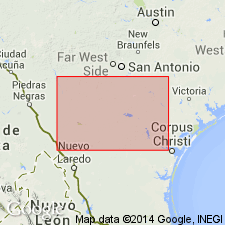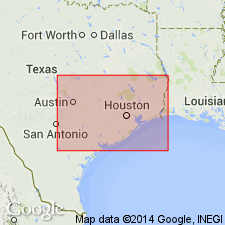
- Usage in publication:
-
- Lipan beds
- Modifications:
-
- Original reference
- Dominant lithology:
-
- Clay
- Sand
- AAPG geologic province:
-
- Gulf Coast basin
Summary:
Pg. 424-436. Lipan beds. The lower or true Fayette. Consists of a series of lignitic clays and sands with bands of sandstone, quartzite, volcanic ash and beds of peaty material, capped by an indurated sandstone with a highly reticulated surface. Thickness probably 150 feet. Unconformably underlies Whitsett beds (previously included in Fayette) and overlies Yegua formation. [Age is Eocene.]
Exposed in Lipan Hills, east of Campbellton [Atascosa Co.], and their extensions to northeast and southwest, where they form a north-facing escarpment which is traceable in a broken line for 20 mi or more, southern Texas Coastal Plain.
[GNC remark (ca. 1930, US geologic names lexicon, USGS Bull. 896, p. 1189): For several years considered same as Fayette sandstone.]
Source: US geologic names lexicon (USGS Bull. 896, p. 1188-1189).

- Usage in publication:
-
- Lipan beds†
- Modifications:
-
- Abandoned
- AAPG geologic province:
-
- Gulf Coast basin
Summary:
Pg. 1311. [†Lipan beds abandoned.] The Whitsett formation of this paper includes all beds from top of Manning beds of McElroy formation to base of the Frio; therefore it includes Lipan beds and Whitsett beds of Dumble.
["Lipan beds" = Fayette sandstone of Dumble, 1894, 1911, and 1924; = "Wellborn beds" of Kennedy (at type); and = Caddell clay (at type) and "Wellborn sandstone" of Dumble, 1915, 1920. (See "Tentative correlation of the named geologic units of Texas," compiled by M.G. Wilmarth, Secretary of Committee on Geologic Names, USGS unpub. corr. chart, Sept. 1930, sheet 1 Triassic-Quaternary.)]
Source: US geologic names lexicon (USGS Bull. 896, p. 1188-1189); GNC TX Triassic-Quaternary Corr. Chart, sheet 1, Sept. 1930.

- Usage in publication:
-
- Lipan member
- Modifications:
-
- Areal extent
- AAPG geologic province:
-
- Gulf Coast basin
Summary:
Pg. 530, 680, 685, 686. Lipan member of Fayette formation. Underlies Whitsett member of the Fayette in central and southern Texas, and is = McElroy and Caddell members of Fayette as now defined in eastern Texas. It is limited at top by the sandstone that caps Lipan Hills and at base by Yegua formation. [Age is Eocene.]
Source: US geologic names lexicon (USGS Bull. 896, p. 1188-1189).
For more information, please contact Nancy Stamm, Geologic Names Committee Secretary.
Asterisk (*) indicates published by U.S. Geological Survey authors.
"No current usage" (†) implies that a name has been abandoned or has fallen into disuse. Former usage and, if known, replacement name given in parentheses ( ).
Slash (/) indicates name conflicts with nomenclatural guidelines (CSN, 1933; ACSN, 1961, 1970; NACSN, 1983, 2005, 2021). May be explained within brackets ([ ]).

